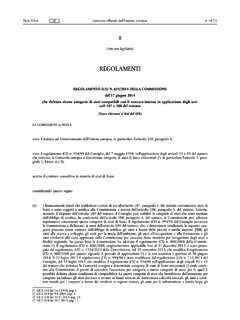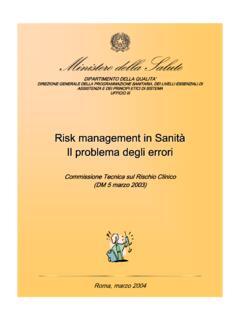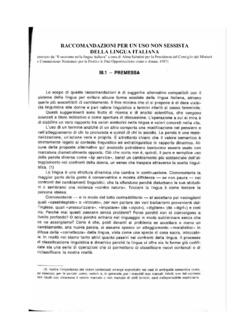Transcription of COMMISSION STAFF WORKING DOCUMENT GUIDANCE …
1 EN EN european COMMISSION Brussels, SWD(2021) 12 final PART 1/2 COMMISSION STAFF WORKING DOCUMENT GUIDANCE TO MEMBER STATES RECOVERY AND RESILIENCE PLANS 1 DISCLAIMER This DOCUMENT is based on the text of the Regulation on the Recovery and Resilience Facility politically agreed between the european Parliament and the Council in December 2020 (2020/0104 (COD)).1 The numbering and the wording of the enacting provisions will change during the ongoing legal revision. This DOCUMENT amends and replaces the STAFF WORKING DOCUMENT on the GUIDANCE to Member States for preparing the recovery and resilience plans (SWD(2020) 205 final) published on 17 September 2020. The DOCUMENT reflects in particular the revised scope and objectives (Articles 3 and 4), the structure of the recovery and resilience plans (Article 15) and the assessment criteria (Article 16 and Annex II) as agreed by the co-legislators.
2 STRUCTURE OF THE DOCUMENT Article 15 of the Regulation outlines the information that Member States need to provide in their recovery and resilience plan. Article 16 and Annex II provide the criteria along which the COMMISSION will assess the plans. The GUIDANCE and the proposed template (annexed) reflect these elements: Part I on the reform and investment objectives covers the overall contribution of the plan to the Regulation s objectives and to the Semester priorities as well as the overall coherence of the plan and its components. Part II covers a description of the individual reforms and investments, structured through components . Part III covers the implementation of the plan and the complementarity with other EU programmes.
3 Part IV covers the expected impact of the plan. TIMELINE Member States are currently preparing their recovery and resilience plans and discussions take place to this effect with the COMMISSION since last year. According to Article 15 of the Regulation, the recovery and resilience plan presented by the Member State concerned may be submitted in a single integrated DOCUMENT together with the National Reform Programme and shall be officially submitted as a rule by 30 April. A draft plan may be submitted by Member States starting from 15 October of the preceding year. Member States are invited to continue the discussions with the COMMISSION on the draft recovery and resilience plans so that the plans can be officially submitted as soon as the Regulation enters into force.
4 1 2 Contents PART 1: GENERAL OBJECTIVES AND COHERENCE OF THE PLAN .. 3 1. General objective/Executive summary .. 3 2. Link with the european Semester .. 7 3. Gender equality and equal opportunities for all .. 10 4. Coherence .. 11 PART 2: DESCRIPTION OF REFORMS AND INVESTMENTS .. 13 1. Description of the component .. 13 2. Investments .. 15 3. Open strategic autonomy and security issues .. 20 4. Cross-border and multi-country projects .. 21 5. Green dimension of the component .. 23 6. Digital dimension of the component .. 26 7. Climate tracking and digital tagging .. 28 8. Do no significant harm .. 32 9. Milestones, targets, timeline .. 33 10. Financing and Costs .. 36 11. Loan request .. 39 PART 3: COMPLEMENTARITY AND IMPLEMENTATION OF THE PLAN.
5 40 1. Consistency with other initiatives .. 40 2. Complementarity of funding .. 42 3. Implementation .. 45 4. Consultation process .. 47 5. Controls and audit .. 47 6. Communication .. 51 PART 4: OVERALL IMPACT .. 52 1. Strengthening the economic, social and institutional resilience .. 52 2. Comparison with the investment baseline .. 55 3 PART 1: GENERAL OBJECTIVES AND COHERENCE OF THE PLAN The recovery and resilience plans need to reflect a substantive reform and investment effort. Both reforms and investments must be coherent and adequately address the challenges in the individual Member State. The reform efforts and investment put forward must be substantial and credible. The COMMISSION will assess the recovery and resilience plans prepared by the Member States on the basis of the criteria set out in Article 16(3) and Annex II of the Regulation.
6 The same assessment procedure will apply for both non-repayable financial contribution and loan requests, as explained later in this GUIDANCE . According to Article 11 of the Regulation, Member States may submit requests up to their maximum financial contribution to implement their recovery and resilience plans. In addition, according to Article 12, Member States can request a loan support, with a maximum ceiling, if they can provide evidence of higher financial needs linked to additional reforms and investments. 1. General objective/Executive summary Background: Article 4(1): In line with the six pillars referred in Article 3, the coherence and synergies they generate, and in the aftermath of the COVID-19 crisis, the general objective of the Recovery and Resilience Facility shall be to promote the Union s economic, social and territorial cohesion by improving the resilience, crisis preparedness, adjustment capacity and growth potential of the Member States, mitigating the social and economic impact of the crisis, in particular on women, contributing to the implementation of the objectives of Union policies, the european Pillar of Social Rights, supporting the green transition.
7 [and contributing to the achievement of the Union s 2030 climate targets set out in Article 2(11) of Regulation (EU) 2018/1999 amended by Article [10] of Regulation [ european Climate Law] and complying with the objective of EU climate neutrality by 2050 and the digital transition, thereby contributing to the upward economic and social convergence, to restoring and promoting sustainable growth and the integration of the economies of the Union, and fostering high quality employment creation, and contributing to the strategic autonomy of the Union alongside an open economy and generating european added value. Article 15 (3) (a-): an explanation on how the recovery and resilience plan, taking into account the measures included therein, represents a comprehensive and adequately balanced response to the economic and social situation of the Member State, thereby contributing appropriately to all pillars set out in Article 3, taking into account the specific challenges of the Member State concerned.]
8 Article 15 (3) (b) a detailed explanation of how the plan strengthens the growth potential, job creation and economic, social and institutional resilience of the Member State concerned, including through the promotion of policies for children and youth, and mitigates the economic and social impact of the crisis, contributing to the implementation of the european Pillar of Social Rights, thereby enhancing the, and its economic, social and territorial cohesion and convergence within the Union; 4 Article 16 (3) (a-): whether the recovery and resilience plan represents a comprehensive and adequately balanced response to the economic and social situation, thereby contributing appropriately to all six pillars set out in Article 3, taking the specific challenges and the funding allocation of the Member State concerned into account; Annex II section Member States are facing a number of challenges aggravated by and/or resulting from the COVID-19 crisis that the Recovery and Resilience Facility will help to address.
9 As an introduction and in line with the requirement of Article 15 to explain how the recovery and resilience plan represents a comprehensive and adequately balanced response to the economic and social situation of the Member State concerned, Member States should describe the main challenges that they are facing under the pillars set out in Article 3 and how the plan represents a comprehensive and adequately balanced response to the economic and social situation of the Member State. The six pillars are: 1. Green transition; 2. Digital transformation; 3. Smart, sustainable and inclusive growth, including economic cohesion, jobs, productivity, competitiveness, research, development and innovation, and a well-functioning single market with strong SMEs; 4.
10 Social and territorial cohesion; 5. Health, and economic, social and institutional resilience, including with a view of increasing crisis reaction and crisis preparedness; and 6. Policies for the next generation, children and youth, including education and skills. Member States are invited to present this section as an executive summary outlining the main narrative of the plan. It should be illustrated by key facts and figures that provide a quantitative insight into the overall estimated impact of the plan and its synergies with other programming instruments. 1. Green transition In line with the political priorities of the Union, the Recovery and Resilience Facility is designed to foster a sustainable and inclusive recovery and promote the green transition, including biodiversity.














